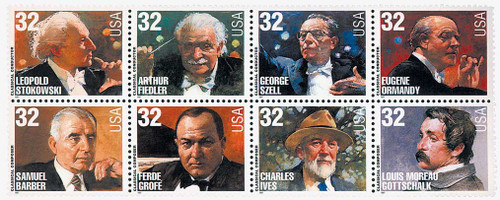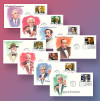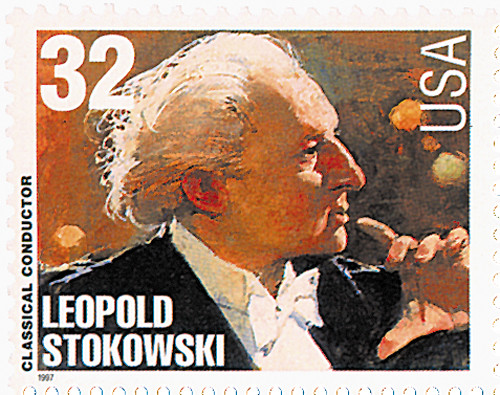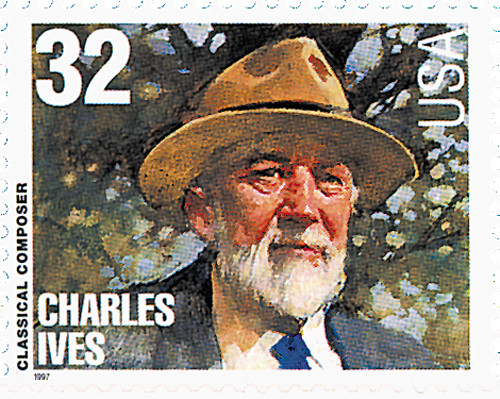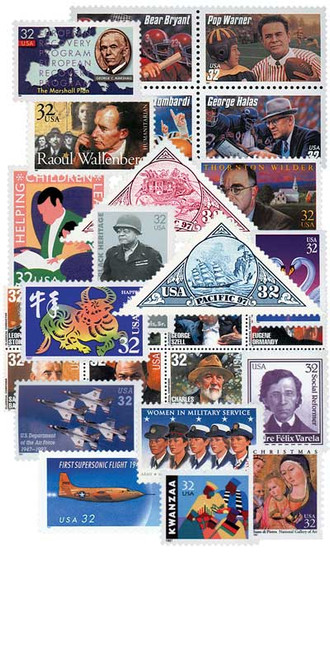
# 3158-65 - 1997 32c Conductors and Composers
US #3158-65
1997 Classical Composers & Conductors
Legends of American Music Series
- Pictures four composers and four conductors who have left their mark on classical music in America
- The 10th stamp set in the Legends of American Music series
Stamp Category: Commemorative
Series: Legends of American Music
Value: 32¢, First Class Mail Rate
First Day of Issue: September 12, 1997
First Day City: Cincinnati, Ohio
Quantity Issued: 86,000,000
Printed by: Printed for Ashton Potter (USA) Ltd. By Sterling Sommer of Tonawanda, New York
Printing Method: Offset
Format: Pane of 20 (Horizontal 4 across, 5 down)
Perforations: 11.1 by 11.0
Tagging: Phosphored paper
Why the stamps were issued: To commemorate composers Samuel Barber, Ferde Grofe, Charles Ives, and Louis Moreau Gottschalk, as well as conductors Leopold Stokowsky, Arthur Fiedler, George Szell, and Eugene Ormandy. They were chosen to represent the best of the best in American classical music.
About the stamp designs: The stamps picture paintings of each composer and conductor by artist Burt Silverman (also responsible for the image on the 1997 Raoul Wallenberg stamp). Art director Howard Paine said he chose Silverman because “He is a mature portrait painter… I didn’t want some glitzy, commercial, airbrush, flashy, tightly rendered kind of art…. Burt’s work is ‘painterly.’ He works in oil, and you can see dabs of color and you see brush strokes and you see the human touch.”
Special design details: A soft-focus background was also included in all eight stamps. Paine said the composers were shown under “little fuzzy balls of color, to suggest out-of-focus light,” while the conductors were all pictured with “a hand up in an expressive gesture.”
First Day City: The First Day of Issue Ceremony for these stamps was held in Cincinnati, Ohio, at the Classical Music Hall of Fame. The city is also home to the Cincinnati Symphony Orchestra, then the fifth oldest symphony orchestra in the United States. It is also home to the Cincinnati Opera, the country’s second-oldest opera company.
About the Legends of American Music Series: The Legends of American Music Series debuted on January 8, 1993, and ran until September 21, 1999. More than 90 artists are represented from all styles of music: rock ‘n’ roll, rhythm and blues, country and western, jazz and pop, opera and classical, gospel and folk. In addition to individual singers and Broadway musicals, subjects include band leaders, classical composers, Hollywood songwriters and composers, conductors, lyricists, and more. The Legends of American Music Series was a huge advancement for diversity because it honored many Black and female artists.
History the stamp represents:
Leopold Stokowski
British-born conductor Leopold Stokowski (1882-1977) was known for his flamboyant showmanship and the rich, deep sound of his orchestra. Stokowski worked as an organist until he became conductor of the Cincinnati Symphony in 1909. From 1912 to 1936 he served as the Philadelphia Orchestra’s musical director. In 1915, he became an American citizen.
Stokowski did a great deal to popularize classical music by organizing the All-American Youth Orchestra and by conducting the NBC symphony. He also directed both the New York Philharmonic and the Houston Symphony. In addition to performing the contemporary works of Mahler, Varèse, and Stravinsky, Stokowski also debuted Charles Ives’ Fourth Symphony. In 1940, he led the Philadelphia Orchestra in creating the music for the classic Walt Disney film Fantasia.
An innovative conductor, Stokowski also studied acoustics and recording techniques, and experimented with the placement of various sections of the orchestra, attempting to improve its range of sound. His refinement ultimately became known as the “Philadelphia” sound. He was also known to change the written orchestration of pieces, which, although often technically brilliant, inspired some controversy.
Arthur Fiedler
Conductor Arthur Fiedler (1894-1979) began studying music early in life. His first teacher was his father, an Austrian-born violinist with the Boston Symphony Orchestra and Kneisel Quartet. As a boy, Fidler studied in Berlin, where he made his musical debut as a violinist at age 17. At the outbreak of World War I, he returned to the United States and joined the Boston Symphony Orchestra as a viola player.
In 1924, Fiedler joined 25 of his fellow players to form the Boston Sinfonietta, later known as the Arthur Fiedler Sinfonietta. In addition to creating greater musical diversity within the city, the ensemble also gave performances in the more remote areas of surrounding states. Starting in 1929, he organized the highly successful Esplanade Concerts in Boston, and a year later he was made conductor of the Boston Pops Orchestra – a position he held for more than 40 years.
Fiedler’s personality, showmanship, and expansion of the symphony’s repertoire (he often included show tunes and arrangements of popular songs) brought great commercial success – a success which extended to television, radio, and recording. Well-loved in the United States, he also earned a wonderful reputation abroad, which was bolstered by his frequent tours of Europe.
George Szell
Born in Hungary, George Szell (1897-1970) grew up in Vienna, Austria. At age 11 he made his debut, performing a piano piece he had composed. Five years later, he conducted the Vienna Symphony Orchestra, and then went on to perform, conduct, and compose with the Berlin Philharmonic Orchestra. From 1946 until his death, Szell conducted the Cleveland Symphony Orchestra, transforming it into one of the world’s greatest orchestras.
Szell demanded precision and clarity from the symphony, using brilliant technique to produce exceptionally powerful music. In fact, his orchestra achieved such incredible balance and clarity that many experts have compared its performances to chamber music.
Unlike many of his contemporaries, who were prone to showmanship and personalized emotionalism, Szell was strict in his interpretation of the pieces he performed. He closely followed the composer’s intentions in an exacting, classical manner. Once, when criticized for a reserved performance of Mozart, Szell replied, “I cannot pour chocolate sauce over asparagus.”
Although he played relatively little contemporary music, Szell did champion the composition of Bartók, Janácek, and Walton.
Eugene Ormandy
Born in Hungary, Eugene Ormandy (1899-1985) gave his first performance as a violinist at the age of seven. By age 17, he had been appointed a professor of the violin and was successfully touring Europe. A trip to New York in 1921 (for a tour which never materialized) forced him to take work with a theater symphony that accompanied silent movies and provided musical interludes. Quickly moving to first violin, Ormandy made his conducting debut there in 1924.
Ormandy became an American citizen in 1927. At that time, he focused his attention on conducting programs of lighter classical music for use in the new medium of radio. In 1930, he began conducting the Philadelphia Orchestra, and from 1938 until 1980, he served as the orchestra’s sole musical director. In 1948, Ormandy conducted the first symphony to be broadcast on American television. Under his leadership, the Philadelphia Orchestra toured many countries and made many recordings.
Ormandy specialized in performances of romantic and neo-romantic music. He often emphasized fine string playing and rich, saturated orchestral tones, causing critics to describe his orchestra’s sound as “voluptuous.”
Samuel Barber
Samuel Barber (1910-1981) started piano lessons at age six. Within a year, he was composing. Even as a child he showed an inclination toward vocal music, as seen by his short opera The Rose Tree, which he performed with the assistance of his sister Sara.
Barber established himself as a serious composer while a student at the Curtiss Institute, which he attended for eight years. His works from this period, including the Serenade for string quartet, Dover Beach, and the Cello Sonata contain the essential ements of his style – successful text-setting and use of tone and orchestrations, as well as long lyrical lines. In 1935, Barber met the legendary conductor Arturo Toscanini. Three years later, Toscanini conducted Barber’s First Essay for orchestra and the Adagio for Strings. The latter remains his most popular work.
Barber’s music was often recognized with awards. He won the 1958 Pulitzer Prize for his four-act opera, Vanessa, and a second Pulitzer in 1962 for his Piano Concerto No. 1. His popular instrumental pieces include The School for Scandal, Capricorn Concerto, and the Concerto for Cello and Orchestra. And Knoxville: Summer of 1915 and Prayers for Kierkegaard are among his popular vocal compositions.
Ferde Grofé
As a child, Ferde Grofé (1892-1972) studied piano, violin, and harmony with his mother, and viola with his grandfather. He performed as a violinist with the Los Angeles Symphony Orchestra for ten years, and also played piano and violin in theater and dance orchestras.
In 1919, the famous conductor Paul Whiteman, known as the “King of Jazz,” heard Grofé’s arrangement of a popular song and hired him. The two formed an important association, with Grofé becoming a leading arranger of “symphonic jazz,” to which Whiteman’s name was closely connected.
Grofé furthered his reputation when he scored George Gershwin’s Rhapsody in Blue. Soon after, he completed his first original composition, Broadway at Night. This was followed by a series of pieces which celebrated the natural beauty of the United States. His best known work, Grand Canyon Suite, which was performed by legendary conductor Arturo Toscanini, achieved wide popularity.
Other noted Grofé compositions include The Hudson River Suite, Niagara Falls Suite, and World’s Fair Suite. Appearances as a conductor with many American symphony orchestras and in radio broadcasts further enhanced Grofé’s popularity.
Charles Ives
Charles Ives (1874-1954) began his musical education with his father, George, who had conducted an Army Band during the Civil War. His father encouraged experimentation, an attitude which would pervade his music. Experts rank Ives among America’s greatest and most original composers.
Although Ives composed his most important works from 1896 to 1921, and had pieces performed as early as 1925, he was not widely known until 1939. Many of his works are unconventional, with key and time signatures and bar lines omitted. One of Ives’ four symphonies, Symphony No. 3, won the 1947 Pulitzer Prize.
Many of Ives’ compositions were based on American folk and popular music, such as ragtime, military marches, patriotic songs, and revival hymns. He also put themes, such as baseball, to music – one of his 27 piano pieces is entitled Some Southpaw Pitching. Some of his music is reminiscent of the circus parades and revival meetings he heard while growing up in Danbury, Connecticut.
Interestingly, Ives never earned his living through music. After graduating from Yale in 1898, he entered the insurance business. He composed during his leisure time, and privately published his creations.
Louis Moreau Gottschalk
Louis Moreau Gottschalk (1829-1869) was able to substitute for his teacher at the cathedral organ during Mass by age seven. At 13 he went to study in Paris, and shortly before his 16th birthday he gave a recital which was attended by Frédéric Chopin, who predicted Gottschalk would become “the king of the pianists.”
In 1849, Gottschalk made his professional debut. Critics immediately compared him to Chpin, and as a composer he was labeled the first authentic musical spokesman for the New World. Gottschalk was especially known for his piano compositions which included The Dying Poet, The Last Hope, and Morte!!
Ethnic influences, especially those of French, Latin-American, Spanish, and West Indian music are demonstrated throughout his pieces. His “Louisiana Trilogy” for piano, titled Bamboula, Le bananier, and La Savane, drew upon the folk music of New Orleans, the city of his birth. While his orchestral piece, A Night in the Tropics, utilizes Latin dance rhythms, Souvenir de Porto Rico is based on a Puerto Rican peasant song.
Several of his compositions have distinctly American themes, such as The Banjo, which is a piano portrait of a minstrel show, and The Union honors the northern soldiers of the Civil War.
US #3158-65
1997 Classical Composers & Conductors
Legends of American Music Series
- Pictures four composers and four conductors who have left their mark on classical music in America
- The 10th stamp set in the Legends of American Music series
Stamp Category: Commemorative
Series: Legends of American Music
Value: 32¢, First Class Mail Rate
First Day of Issue: September 12, 1997
First Day City: Cincinnati, Ohio
Quantity Issued: 86,000,000
Printed by: Printed for Ashton Potter (USA) Ltd. By Sterling Sommer of Tonawanda, New York
Printing Method: Offset
Format: Pane of 20 (Horizontal 4 across, 5 down)
Perforations: 11.1 by 11.0
Tagging: Phosphored paper
Why the stamps were issued: To commemorate composers Samuel Barber, Ferde Grofe, Charles Ives, and Louis Moreau Gottschalk, as well as conductors Leopold Stokowsky, Arthur Fiedler, George Szell, and Eugene Ormandy. They were chosen to represent the best of the best in American classical music.
About the stamp designs: The stamps picture paintings of each composer and conductor by artist Burt Silverman (also responsible for the image on the 1997 Raoul Wallenberg stamp). Art director Howard Paine said he chose Silverman because “He is a mature portrait painter… I didn’t want some glitzy, commercial, airbrush, flashy, tightly rendered kind of art…. Burt’s work is ‘painterly.’ He works in oil, and you can see dabs of color and you see brush strokes and you see the human touch.”
Special design details: A soft-focus background was also included in all eight stamps. Paine said the composers were shown under “little fuzzy balls of color, to suggest out-of-focus light,” while the conductors were all pictured with “a hand up in an expressive gesture.”
First Day City: The First Day of Issue Ceremony for these stamps was held in Cincinnati, Ohio, at the Classical Music Hall of Fame. The city is also home to the Cincinnati Symphony Orchestra, then the fifth oldest symphony orchestra in the United States. It is also home to the Cincinnati Opera, the country’s second-oldest opera company.
About the Legends of American Music Series: The Legends of American Music Series debuted on January 8, 1993, and ran until September 21, 1999. More than 90 artists are represented from all styles of music: rock ‘n’ roll, rhythm and blues, country and western, jazz and pop, opera and classical, gospel and folk. In addition to individual singers and Broadway musicals, subjects include band leaders, classical composers, Hollywood songwriters and composers, conductors, lyricists, and more. The Legends of American Music Series was a huge advancement for diversity because it honored many Black and female artists.
History the stamp represents:
Leopold Stokowski
British-born conductor Leopold Stokowski (1882-1977) was known for his flamboyant showmanship and the rich, deep sound of his orchestra. Stokowski worked as an organist until he became conductor of the Cincinnati Symphony in 1909. From 1912 to 1936 he served as the Philadelphia Orchestra’s musical director. In 1915, he became an American citizen.
Stokowski did a great deal to popularize classical music by organizing the All-American Youth Orchestra and by conducting the NBC symphony. He also directed both the New York Philharmonic and the Houston Symphony. In addition to performing the contemporary works of Mahler, Varèse, and Stravinsky, Stokowski also debuted Charles Ives’ Fourth Symphony. In 1940, he led the Philadelphia Orchestra in creating the music for the classic Walt Disney film Fantasia.
An innovative conductor, Stokowski also studied acoustics and recording techniques, and experimented with the placement of various sections of the orchestra, attempting to improve its range of sound. His refinement ultimately became known as the “Philadelphia” sound. He was also known to change the written orchestration of pieces, which, although often technically brilliant, inspired some controversy.
Arthur Fiedler
Conductor Arthur Fiedler (1894-1979) began studying music early in life. His first teacher was his father, an Austrian-born violinist with the Boston Symphony Orchestra and Kneisel Quartet. As a boy, Fidler studied in Berlin, where he made his musical debut as a violinist at age 17. At the outbreak of World War I, he returned to the United States and joined the Boston Symphony Orchestra as a viola player.
In 1924, Fiedler joined 25 of his fellow players to form the Boston Sinfonietta, later known as the Arthur Fiedler Sinfonietta. In addition to creating greater musical diversity within the city, the ensemble also gave performances in the more remote areas of surrounding states. Starting in 1929, he organized the highly successful Esplanade Concerts in Boston, and a year later he was made conductor of the Boston Pops Orchestra – a position he held for more than 40 years.
Fiedler’s personality, showmanship, and expansion of the symphony’s repertoire (he often included show tunes and arrangements of popular songs) brought great commercial success – a success which extended to television, radio, and recording. Well-loved in the United States, he also earned a wonderful reputation abroad, which was bolstered by his frequent tours of Europe.
George Szell
Born in Hungary, George Szell (1897-1970) grew up in Vienna, Austria. At age 11 he made his debut, performing a piano piece he had composed. Five years later, he conducted the Vienna Symphony Orchestra, and then went on to perform, conduct, and compose with the Berlin Philharmonic Orchestra. From 1946 until his death, Szell conducted the Cleveland Symphony Orchestra, transforming it into one of the world’s greatest orchestras.
Szell demanded precision and clarity from the symphony, using brilliant technique to produce exceptionally powerful music. In fact, his orchestra achieved such incredible balance and clarity that many experts have compared its performances to chamber music.
Unlike many of his contemporaries, who were prone to showmanship and personalized emotionalism, Szell was strict in his interpretation of the pieces he performed. He closely followed the composer’s intentions in an exacting, classical manner. Once, when criticized for a reserved performance of Mozart, Szell replied, “I cannot pour chocolate sauce over asparagus.”
Although he played relatively little contemporary music, Szell did champion the composition of Bartók, Janácek, and Walton.
Eugene Ormandy
Born in Hungary, Eugene Ormandy (1899-1985) gave his first performance as a violinist at the age of seven. By age 17, he had been appointed a professor of the violin and was successfully touring Europe. A trip to New York in 1921 (for a tour which never materialized) forced him to take work with a theater symphony that accompanied silent movies and provided musical interludes. Quickly moving to first violin, Ormandy made his conducting debut there in 1924.
Ormandy became an American citizen in 1927. At that time, he focused his attention on conducting programs of lighter classical music for use in the new medium of radio. In 1930, he began conducting the Philadelphia Orchestra, and from 1938 until 1980, he served as the orchestra’s sole musical director. In 1948, Ormandy conducted the first symphony to be broadcast on American television. Under his leadership, the Philadelphia Orchestra toured many countries and made many recordings.
Ormandy specialized in performances of romantic and neo-romantic music. He often emphasized fine string playing and rich, saturated orchestral tones, causing critics to describe his orchestra’s sound as “voluptuous.”
Samuel Barber
Samuel Barber (1910-1981) started piano lessons at age six. Within a year, he was composing. Even as a child he showed an inclination toward vocal music, as seen by his short opera The Rose Tree, which he performed with the assistance of his sister Sara.
Barber established himself as a serious composer while a student at the Curtiss Institute, which he attended for eight years. His works from this period, including the Serenade for string quartet, Dover Beach, and the Cello Sonata contain the essential ements of his style – successful text-setting and use of tone and orchestrations, as well as long lyrical lines. In 1935, Barber met the legendary conductor Arturo Toscanini. Three years later, Toscanini conducted Barber’s First Essay for orchestra and the Adagio for Strings. The latter remains his most popular work.
Barber’s music was often recognized with awards. He won the 1958 Pulitzer Prize for his four-act opera, Vanessa, and a second Pulitzer in 1962 for his Piano Concerto No. 1. His popular instrumental pieces include The School for Scandal, Capricorn Concerto, and the Concerto for Cello and Orchestra. And Knoxville: Summer of 1915 and Prayers for Kierkegaard are among his popular vocal compositions.
Ferde Grofé
As a child, Ferde Grofé (1892-1972) studied piano, violin, and harmony with his mother, and viola with his grandfather. He performed as a violinist with the Los Angeles Symphony Orchestra for ten years, and also played piano and violin in theater and dance orchestras.
In 1919, the famous conductor Paul Whiteman, known as the “King of Jazz,” heard Grofé’s arrangement of a popular song and hired him. The two formed an important association, with Grofé becoming a leading arranger of “symphonic jazz,” to which Whiteman’s name was closely connected.
Grofé furthered his reputation when he scored George Gershwin’s Rhapsody in Blue. Soon after, he completed his first original composition, Broadway at Night. This was followed by a series of pieces which celebrated the natural beauty of the United States. His best known work, Grand Canyon Suite, which was performed by legendary conductor Arturo Toscanini, achieved wide popularity.
Other noted Grofé compositions include The Hudson River Suite, Niagara Falls Suite, and World’s Fair Suite. Appearances as a conductor with many American symphony orchestras and in radio broadcasts further enhanced Grofé’s popularity.
Charles Ives
Charles Ives (1874-1954) began his musical education with his father, George, who had conducted an Army Band during the Civil War. His father encouraged experimentation, an attitude which would pervade his music. Experts rank Ives among America’s greatest and most original composers.
Although Ives composed his most important works from 1896 to 1921, and had pieces performed as early as 1925, he was not widely known until 1939. Many of his works are unconventional, with key and time signatures and bar lines omitted. One of Ives’ four symphonies, Symphony No. 3, won the 1947 Pulitzer Prize.
Many of Ives’ compositions were based on American folk and popular music, such as ragtime, military marches, patriotic songs, and revival hymns. He also put themes, such as baseball, to music – one of his 27 piano pieces is entitled Some Southpaw Pitching. Some of his music is reminiscent of the circus parades and revival meetings he heard while growing up in Danbury, Connecticut.
Interestingly, Ives never earned his living through music. After graduating from Yale in 1898, he entered the insurance business. He composed during his leisure time, and privately published his creations.
Louis Moreau Gottschalk
Louis Moreau Gottschalk (1829-1869) was able to substitute for his teacher at the cathedral organ during Mass by age seven. At 13 he went to study in Paris, and shortly before his 16th birthday he gave a recital which was attended by Frédéric Chopin, who predicted Gottschalk would become “the king of the pianists.”
In 1849, Gottschalk made his professional debut. Critics immediately compared him to Chpin, and as a composer he was labeled the first authentic musical spokesman for the New World. Gottschalk was especially known for his piano compositions which included The Dying Poet, The Last Hope, and Morte!!
Ethnic influences, especially those of French, Latin-American, Spanish, and West Indian music are demonstrated throughout his pieces. His “Louisiana Trilogy” for piano, titled Bamboula, Le bananier, and La Savane, drew upon the folk music of New Orleans, the city of his birth. While his orchestral piece, A Night in the Tropics, utilizes Latin dance rhythms, Souvenir de Porto Rico is based on a Puerto Rican peasant song.
Several of his compositions have distinctly American themes, such as The Banjo, which is a piano portrait of a minstrel show, and The Union honors the northern soldiers of the Civil War.

